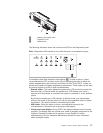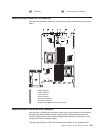
v Follow the suggested actions in the order in which they are listed in the Action column until the problem
is solved.
v See the parts listing in the Hardware Maintenance Manual to determine which components are customer
replaceable units (CRU) and which components are field replaceable units (FRU).
v If an action step is preceded by “(Trained service technician only),” that step must be performed only by a
trained service technician.
LED Description Action
PCI An error has occurred on a PCI bus or
on the system board. An additional LED
will be lit next to a failing PCI slot.
1. Check the LEDs on the PCI slots to identify the component
that is causing the error.
2. Check the system-event log for information about the error.
3. If you cannot isolate the failing adapter through the LEDs
and the information in the system-event log, remove one
adapter at a time from the failing PCI bus, and restart the
server after each adapter is removed.
4. Call for service.
SP
™
The service processor (the IMM) has
failed.
1. Remove power from the server; then, reconnect the server
to power and restart the server.
2. Update the firmware on the IMM.
3. Call for service
FAN A fan has failed, is operating too slowly,
or has been removed. The TEMP LED
might also be lit.
Replace the failing fan, which is indicated by a lit LED near the
fan connector on the system board.
TEMP The system temperature has exceeded
a threshold level. A failing fan can
cause the TEMP LED to be lit.
1. Check the error log to identify where the over-temperature
condition was measured. If a fan has failed, replace it.
2. Make sure that the room temperature is not too high. See
Table 3 on page 11 for temperature information.
3. Make sure that the air vents are not blocked.
4. Call for service.
Chapter 4. Server controls, LEDs, and power 19


















